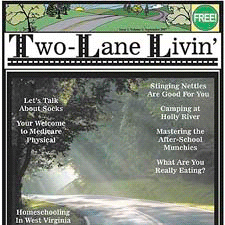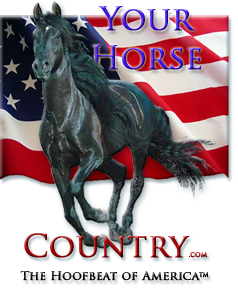| Sponsors:




|
Two Lane Livin' Your Horse
Country Column archives...
April
2011 - Root crops as fodder for horses, cows, sheep, chickens, and other
critters, including YOU!
Written by Dawna B. Smith,
Journalist and Reporter, writer of the monthly "Your Horse Country" column for
Two Lane Livin' Magazine
Flat
land, a valued commodity in
West Virginia
, is prized for home sites and gardens, but most often is reserved for
narrow hay fields that hug creeks and our serpentine roads. Mountain top
hay meadows aren’t usually conducive to producing large round bales, as
they tend to want to roll down the hill. They also tend to be drier and
not produce as much forage, as our water soaked valleys do. So, hay is
often square baled on hill sides where flatlanders would not even dream of
driving a tractor or four-wheeler. Twenty-two percent of
West Virginia
residents are disabled, and it’s possible that our rough farming terrain
and joy of outdoor sports are contributing factors.
Horses
and cattle are often restricted to eating just hay that has been cut and
stored for winter feeding. But how nutritious is your hay? Few people have
their hay tested for nutrient content. Harvest time can affect nutrition
levels, as well as can the soil’s health in which it was grown. The cost
of grain, fertilizer and fuel has been skyrocketing. A couple years ago,
round hay bales were selling from $65 to $125 each, due to drought in one
part of the country and a very wet summer in others. Fuel is expected to
hit $5 per gallon by the end of summer, with diesel being more expensive.
What
can we do to help ensure nutritious winter feed for us and our animals?
Consider
planting fodder beets! The
versatile beet (Beta vulgaris) is a plant in the Chenopodiaceae
family.
The
most well known is the purple garden beet. Other cultivated varieties
include the leaf vegetables chard
and spinach
beet,
as well as the root vegetables sugar
beet,
which is important in the production of table
sugar,
and mangelwurzel,
which is a fodder
crop.
Mangelwurzel
or mangold wurzel comes
from the German
Mangel/Mangold, "chard",
and Wurzel, "root". It’s also called mangold,
mangel beet, field
beet and fodder beet, and is a cultivated root
vegetable
derived from Beta
vulgaris.
Its large white, yellow or orange-yellow swollen roots were developed in
the 18th century as a fodder
crop for feeding livestock.
Beet pulp has been historically fed to horses that are in vigorous
training or conditioning, and to those that may be allergic to dust from
hay.
For
those of you with a sweet tooth, back in the mid 18th century
people got tired of waiting for cane sugar to be brought by ships that
took months, so the King of Prussia paid for sugar extraction experiments.
In 1747 Andreas Marggraf was able to isolate sugar from beetroots,
demonstrating it could be extracted and produce sugar that was the same as
the stuff produced from sugarcane. Archard, a student of Marggraf, then
evaluated 23 varieties of mangelwurzel for their sugar content. It was
Koppy and his son who further selected a specific white tuber, the white
Silesian sugar beet, that had about a 6% sugar content, which is the
progenitor of all modern sugar beets.
The
Silesian beet was soon introduced to
France
, and Napoleon decreed that schools be established specifically for
studying the plant, ordering 69,200 acres be placed into production.
British blockades of cane sugar helped spur the European sugar beet
industry. In 1840, only 5% of the world’s sugar came from sugar beets,
and by 1880 over 50%! What did they do with the pulp? They fed it to
livestock, which thrive on the stuff.
Fodder
beet is the highest yielding forage crop any one can grow, and
depending on the variety, the root can have a protein content as high as
8%, with the tops even higher. WARNING: They can grow as large as 25
pounds each in good soil conditions. Due to their large size and being fun
to throw, the Mangold Hurling Association was formed. You can learn more
about the game and see photos of various size Mangolds at http://www.mangoldhurling.co.uk/
If
planted in clay type soil, they won’t grow as large, but will help open
up and improve your soil. Energy rich fodder beets complement the use
of grass or protein rich legumes in the diet of horses and cattle. In
many countries, like wet and cool
England
, they serve as winter feed. In other countries fodder beets play an
important role in supplying forage in dry periods late in the summer.
Animals love to eat the tops! One acre can produce up to 4 tons of edible
tops alone, plus 30 to 35 tons of root crop.
Fodder
beets have very high digestibility, and the yield and forage quality
of beets don’t vary much from year to year. With all the uncertainty
that life brings, fodder beets can help bring security and stability in
feed production planning. Worst case scenario, your family can benefit
from their consumption as well as your livestock! Fodder beets have a
long growing season and help retain important nitrogen in the soil, which
greatly benefits the environment and your pocketbook (less need for
fertilizer).
For
you cattle producers out there, one study showed that beet pulp is higher
in crude protein than corn. The results showed that beet pulp could be a
satisfactory source of energy in rations for growing and fattening
ruminants. To formulate high energy rations used in sheep and beef feed
lots, beet pulp alone could serve as a sole energy source. Beet pulp by
virtue of its physical nature, digestible nutrient content and nutrient
availability for optimum microbial degradation followed by uninterrupted
absorption from vigorous gastrointestinal tract seems to be superior to
high energy grains in practical sheep and beef production.
As
reported by World’s Healthiest Foods at http://www.whfoods.com,
“Beets are a unique source of phytonutrients called betalains. Betanin
and vulgaxanthin are the two best-studied betalains from beets, and both
have been shown to provide antioxidant, anti-inflammatory, and
detoxification support.”
It
also mentioned that “An estimated 10-15% of all
U.S.
adults experience beeturia (a reddening of the urine) after consumption of
beets in everyday amounts. Individuals with iron deficiency, iron excess,
or specific problems with iron metabolism are much more likely to
experience beeturia than individuals with healthy iron metabolism. For
this reason, if you experience beeturia and have any reason to suspect
iron-related problems, we recommend a healthcare consult to follow up on
possible issues related to iron status.”
As
big as these things can grow, if you don’t have a tractor to help you
harvest, all I can say is “Happy Hurling!!!”.
Bio:
Dawna Smith,
Journalist and Reporter, writes the monthly column "Your Horse
Country" for Two Lane
Livin' Magazine, based in West Virginia, as well as numerous articles regarding pain related medical issues for
LivePainFreeNow.com. A photographer and free lance writer, her op-ed articles have been published regarding a variety of subjects.
She and her husband have been strong advocates for the elderly and disabled since 1998,
and formed the non-profit HEADINGS (helping elderly and disabled in need gain support) to help ensure that legislature, Department of Health and Human Resources, and the Centers for Medicare and Medicaid heard their voices.
She can be reached at dawna @ yourhorsecountry.com
304-765-0490.
|




